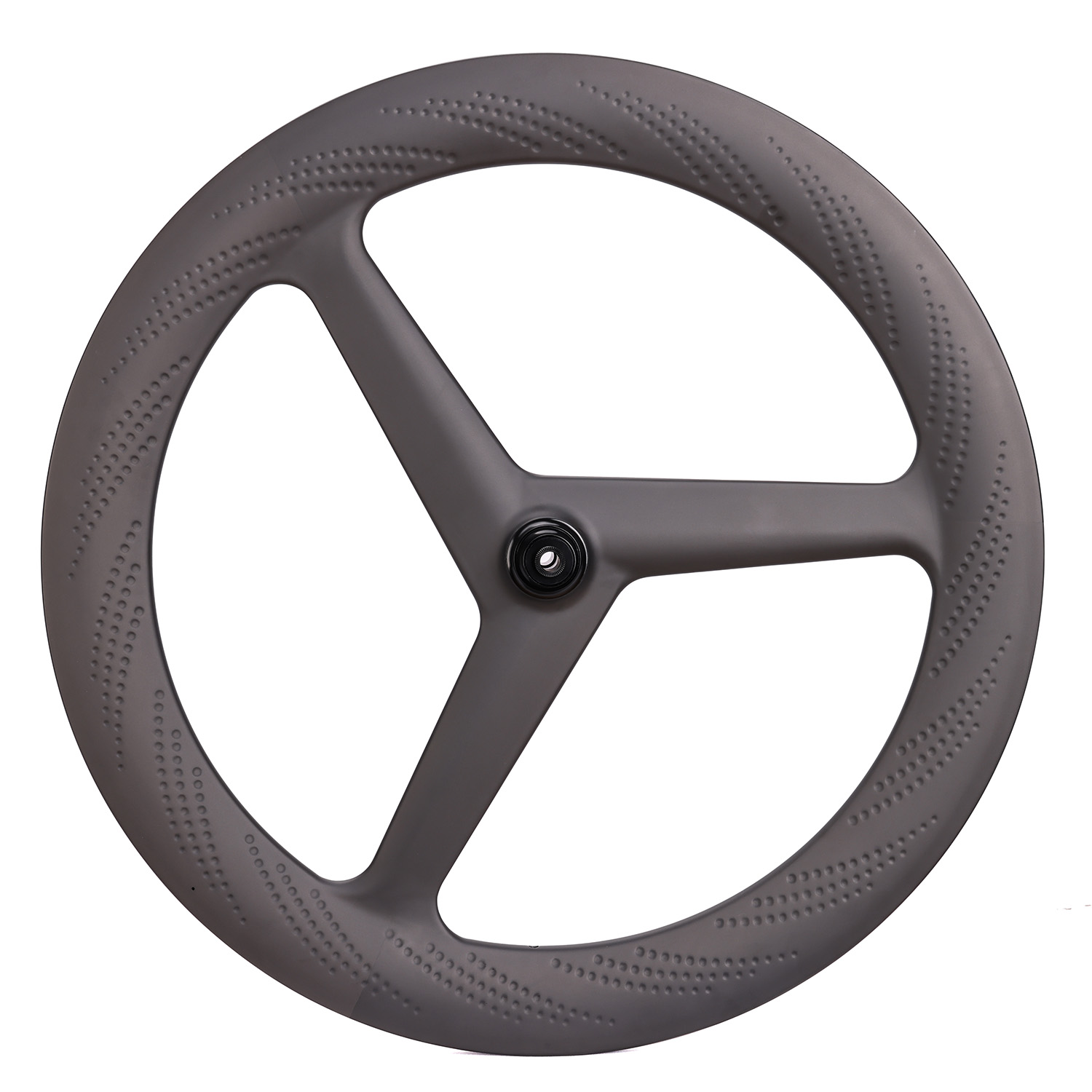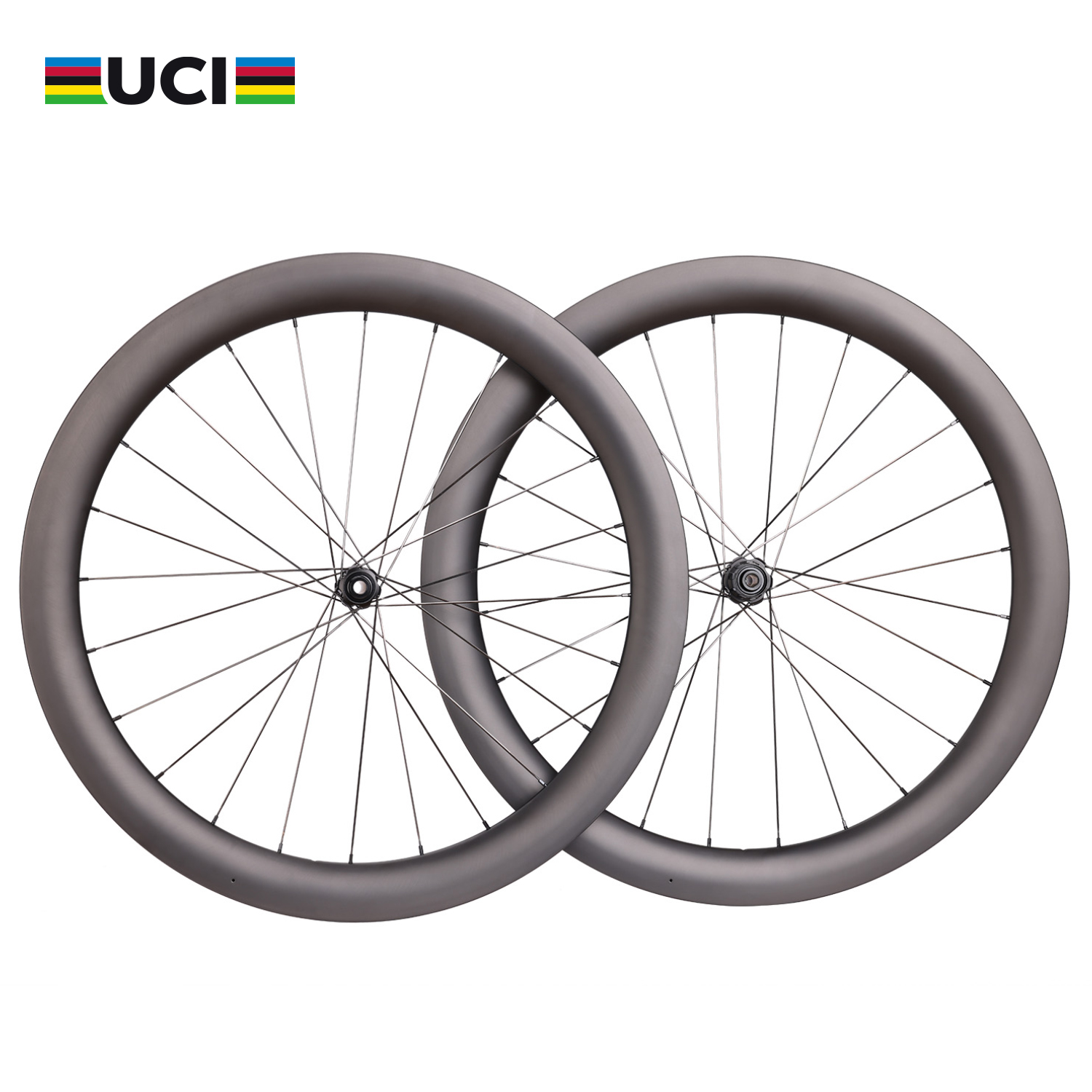Road Bike Tire Pressure Guide: Essential Knowledge You Need to Know
Road Bike Tire Pressure Guide: Essential Knowledge You Need to Know
The days of simply inflating your road bike tires to the maximum supported pressure and hoping for the best are long gone. Excessively high pressure not only feels uncomfortable but has also been proven to slow you down. Optimizing your road bike tire pressure is one of the simplest and most cost-effective ways to enhance both performance and comfort.
For cycling newcomers, it’s not always clear what pressure to inflate your tires to. While most tires have a recommended pressure range printed on the sidewall, there’s rarely more detailed guidance than that. The correct tire pressure for a road bike depends on the rider, the bike, and the road conditions. This might sound complicated, but getting into the right pressure range is far from difficult.
Whether you’re a beginner or an experienced rider looking to optimize your road bike’s performance, we’re here to help. Finding the right tire pressure for your road bike also ties into riding balance. Your tire pressure needs to be high enough to minimize energy loss from tire deformation while providing controllable cornering. But it also needs to be low enough to absorb road imperfections without bouncing you and your bike into the air.
In this article, we’ll explain why tire pressure matters so much, what factors influence the ideal pressure, and how to find the sweet spot for you.
Key Factors to Consider
Before diving into the details, here are the four critical factors to keep in mind when it comes to road bike tire pressure.
Why Bother?
Under-inflated tires can pinch against the rim, causing flats or rim damage.
At its core, maintaining proper tire pressure makes your ride easier, more comfortable, and reduces the risk of flats. From a performance standpoint, optimized pressure is key to minimizing rolling resistance and maximizing comfort. Rolling resistance is the force that opposes the tire’s motion as it rolls over the surface.
If your tire pressure is too low, more energy is wasted on tire deformation and friction with the road. It also increases the chance of “snake bites” (pinch flats). If pressure is too high, the tire becomes overly rigid, causing your bike to vibrate over bumps—this drastically reduces comfort and drains your energy.
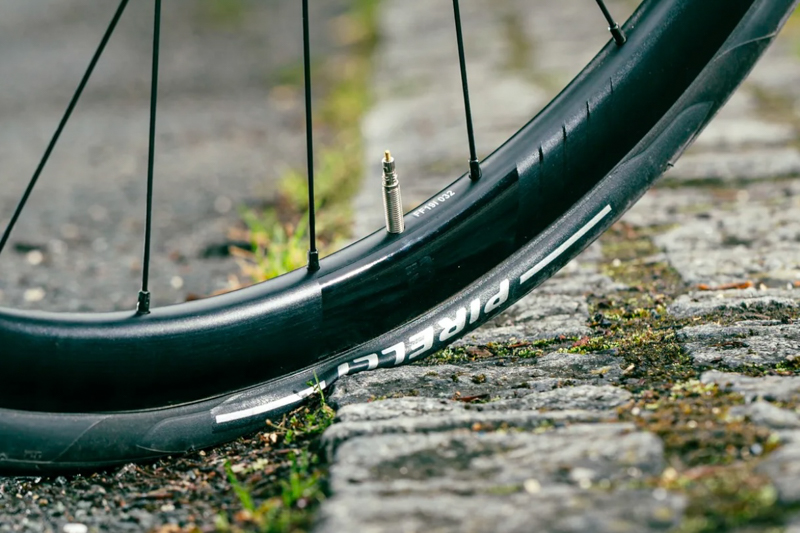
Feels Fast, But Isn’t Actually Faster
Very high tire pressure might feel fast, but it isn’t. Once you exceed a certain point, adding more air reduces grip, increases high-frequency vibrations, and causes unnecessary muscle fatigue—all of which slow you down. The goal is to find a pressure that makes you both faster and more comfortable.
Tools You’ll Need
To set accurate tire pressure on your road bike, use a floor pump with a built-in pressure gauge. You don’t need to spend a fortune, but since you’ll use it long-term, investing in a quality one pays off.
Play It Safe
When in doubt, err on the side of lower pressure rather than higher. According to Silca’s testing, performance drops off sharply once you exceed the optimal pressure for a given setup. Slightly low pressure causes only minor speed loss but significantly improves comfort on rough roads.
Recommended Road Bike Tire Pressures
The good news? Many tire manufacturers provide pressure recommendations or reference charts for their road tire lines. These are excellent starting points for dry conditions on smooth asphalt. As we’ll discuss, pay close attention to the actual inflated tire width—this can shift the ideal pressure for any wheel/tire combo.
If your inflated tire measures wider than its labeled size, you’ll need slightly lower pressure than recommended—and vice versa. Heavier riders or those carrying loads will need higher pressures, while lighter riders can run lower. Finally, never exceed the maximum pressure limits set by the tire or rim manufacturer—especially with hookless rims, which often have much lower max pressures.
Below are general guidelines for tubeless road tires. These work well across brands as long as you factor in the variables we’ll cover later.
Recommended Road Bike Tire Pressures
The good news? Many tire manufacturers provide pressure recommendations or reference charts for their road tire lines. These are excellent starting points for dry conditions on smooth asphalt. As we’ll discuss, pay close attention to the actual inflated tire width—this can shift the ideal pressure for any wheel/tire combo.
If your inflated tire measures wider than its labeled size, you’ll need slightly lower pressure than recommended—and vice versa. Heavier riders or those carrying loads will need higher pressures, while lighter riders can run lower. Finally, never exceed the maximum pressure limits set by the tire or rim manufacturer—especially with hookless rims, which often have much lower max pressures.
Tire pressure for 23mm and 25mm tires
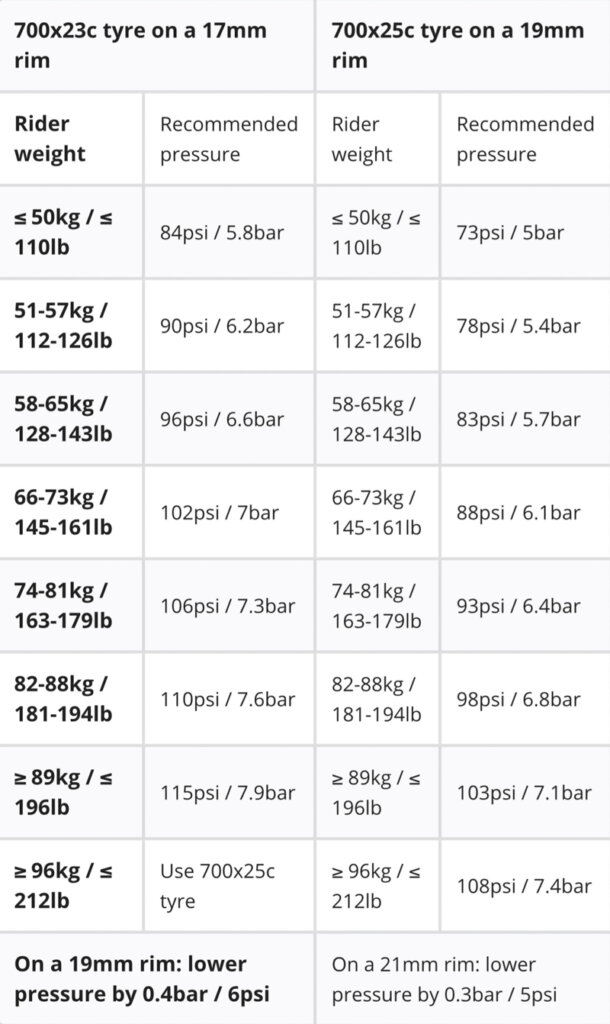
Here are some recommendations for road bike tubeless tires, but no matter which brand of tire you use, as long as you consider the various factors we’ll discuss later when fine-tuning the tire pressure, these will all be good initial fine-tuning suggestions.
Tire pressure for 28mm and 30mm tires
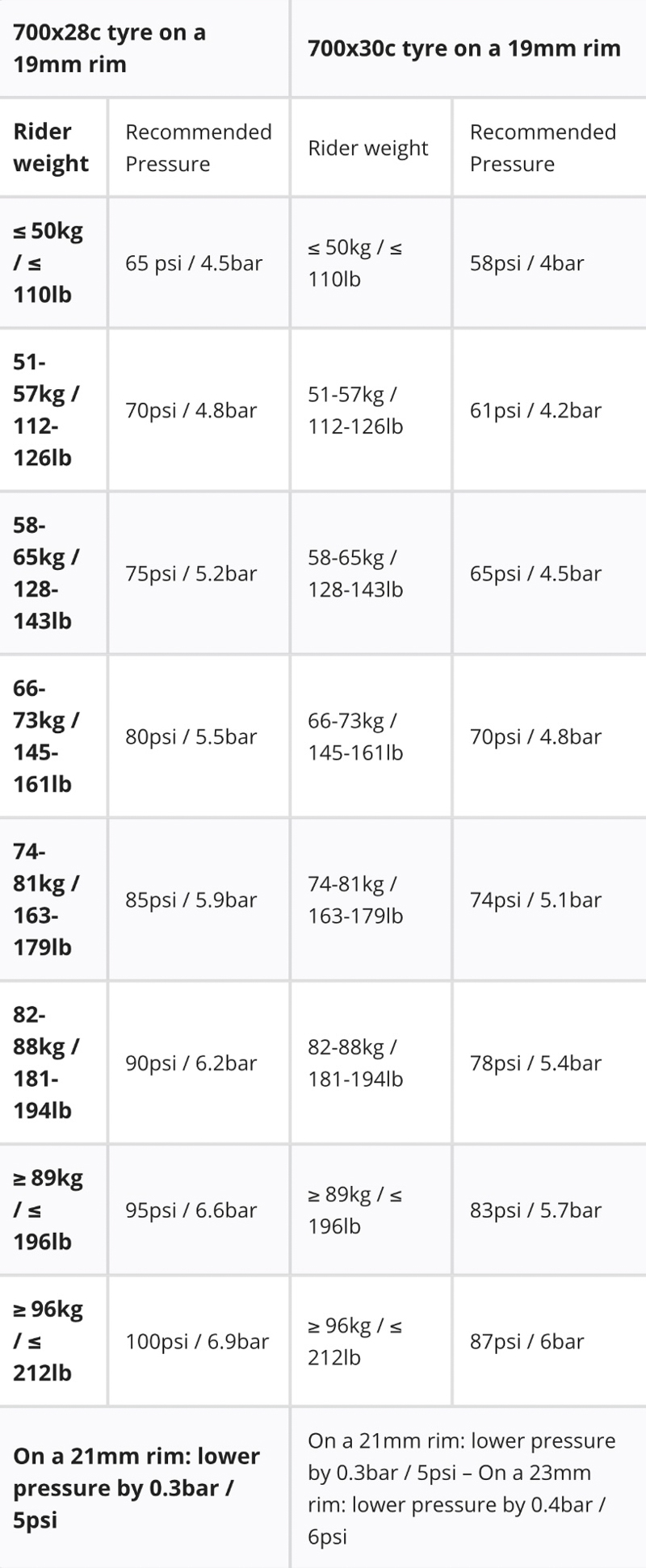
Below are general guidelines for tubeless road tires. These work well across brands as long as you factor in the variables we’ll cover later.
Note: Riders over 96kg (212 lbs) should use 700×25c or larger tires, as recommended pressures for heavier riders often exceed the limits of 700×23c tires. Always respect marked maximums.
Personal Example
For context: I weigh ~63–64kg. Time trials are my passion. On my TT bike with 19mm internal-width rims and 23mm tires (which inflate closer to 25mm), I run ~90 psi front and rear on smooth, flat courses. On rough, potholed roads, I drop to around 65 psi.
Factors That Affect Optimal Tire Pressure
The recommendations above are starting points. They’ll get you close, but beyond tire/rim size and rider weight, several other factors influence your personal sweet spot.
Size Matters

Inflated tire width varies depending on rim internal width. Measuring actual size is crucial for calculating ideal pressure.
Most modern road tires are designed around 19mm internal rim widths (per 2020 ETRTO standards). Wider rims make tires balloon slightly, increasing measured width—and thus requiring lower optimal pressure than on narrower rims.
Total System Weight & Weight Distribution

Riding a lightweight race bike? All else equal, you’ll need less pressure than on a loaded touring rig. Rider weight dominates, but bike + gear weight matters too. No panniers? Drop a few psi. Fully loaded? Add air.
On road bikes, weight isn’t evenly distributed—most riders put more load on the rear wheel. As a rule of thumb, run the front tire ~5–10 psi lower than the rear.
Road Surface

Smooth velodrome? Higher pressure = faster. Real-world roads? Too much air increases vibration and slows you down.
As surfaces get rougher, drop pressure further. On very broken roads, narrow tires (25mm or less) at low pressure may not protect the rim or tube enough—especially for heavier riders—risking pinch flats or rim damage.
On gravel-strewn or cobbled roads (think Paris-Roubaix), pros drop to 28mm+ tires and lower pressures for compliance and grip.
Weather & Temperature

Slightly lower pressure in the wet improves traction.
Drop both tires ~5 psi in wet conditions to increase rubber contact patch and grip. Heat—ambient or from rim brakes—increases tire pressure.
On hot days with rim-brake carbon clinchers (especially with latex tubes), avoid over-inflating before long descents. Excess heat can build dangerous pressure inside the tire.
Tire Construction
Race/summer tires use finer nylon or cotton threads (higher TPI) and thinner rubber—more supple, faster, but require slightly higher pressure. Winter/training tires are tougher, with thicker tread and lower TPI—run them a bit softer for comfort and puncture protection.
Tubeless Tires
With no inner tube, you can safely run much lower pressures without pinch flat risk. This is especially useful for light gravel or mixed-terrain riding on wider road tires.
Fine-Tuning Your Road Bike Tire Pressure
Start with the recommendations above, then adjust based on your local roads. Riding on glass-smooth fresh asphalt? You’re probably close. Living somewhere with patched, potholed tarmac (like much of the UK)? Start 5 psi lower and experiment.
Drop pressure in ~5 psi increments per ride until you find the sweet spot: smooth rolling, confident cornering without tire squirm. And remember: better to be slightly under-inflated than over.









